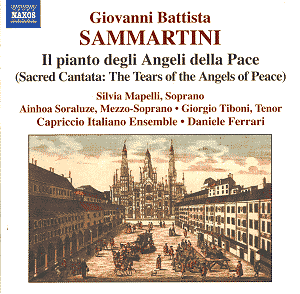Sammartini was a hugely
fecund composer and had a long musical
career. He spanned the age from Vivaldi
to the emergence of Haydn and the young
Mozart. His music is thus an important
feature in the transitional period between
baroque and classical. Though he worked
as a maestro di capella and as an organist
at a number of churches in Milan, not
more than twenty or so of his sacred
compositions survive.
The cantata Il piano
degli Angeli della pace was first
performed in 1751 at the church of St.
Fedele in Milan and it is written for
three soloists, accompanied by an orchestra
consisting of strings, oboes, horns
and basso continuo.
The plot, such as it
is, concerns itself with a discussion
between three angels, the Angel of the
Alliance, the Angel of the Testament
and the Angel of Grace, about the history
of salvation and the fulfilment through
Christ. The cantata consists of an orchestral
introduction, a trio which occurs three
times within the piece and a da capo
aria for each of the characters, all
linked by recitative. The three da capo
arias are very substantial and represent
a total of 26 minutes in a 45 minute
work.
The work could easily
come over as undramatic if not performed
sympathetically. Whilst the three soloists
are up to the technical challenges that
the piece presents, none of them really
conveys the drama inherent in the words.
This is partly because only the soprano,
Silvia Mapelli, has a voice which is
truly suitable stylistically to the
music. She sings her aria creditably
but without bringing to it any élan
or sense of the religious sentiment
of the words. Alto Ainhoa Soraluze has
a vibrato-laden voice and her experience
seems to have been in 19th
century opera. She fails to bring to
the work the necessary sense of line
that the music needs.
Tenor Giorgio Tiboni
is the most problematic of the three
singers. He chooses to sing the role
in a rather throat, vibrato-less tone
which reminded me of Jantina Noorman.
It is a timbre that I am more used to
hearing in earlier music than Sammartiniís.
Perhaps a case could be made for it,
but it contrasts alarmingly with the
more traditional sounds of the two womenís
voices and the three voices do not gel
in the crucial trios which punctuate
the piece.
The Capriccio Italiano
Ensemble play the opening introduction
in a lively style, characterised more
by vigour than style; but they do bring
out Sammartiniís undoubted confidence
in handling orchestral forces. Throughout
the piece they support the singers well
and in the soprano aria with its large
cello solo, the anonymous cellist contributes
some stylish playing. They really come
into their own in the Symphony in E
flat accompanies the cantata on the
disc; here we can appreciate Sammartini
in the instrumental writing that he
seems to do best.
I wish I could be more
enthusiastic about this disc; Naxos
obviously hope that Sammartiniís extensive
catalogue can provide some fine nuggets
in the way that other composerís catalogues
have been mined. Unfortunately this
performance does the work few favours
and as far as I am concerned, the jury
is still out.
Robert Hugill
see also review
by Jonathan Woolf







